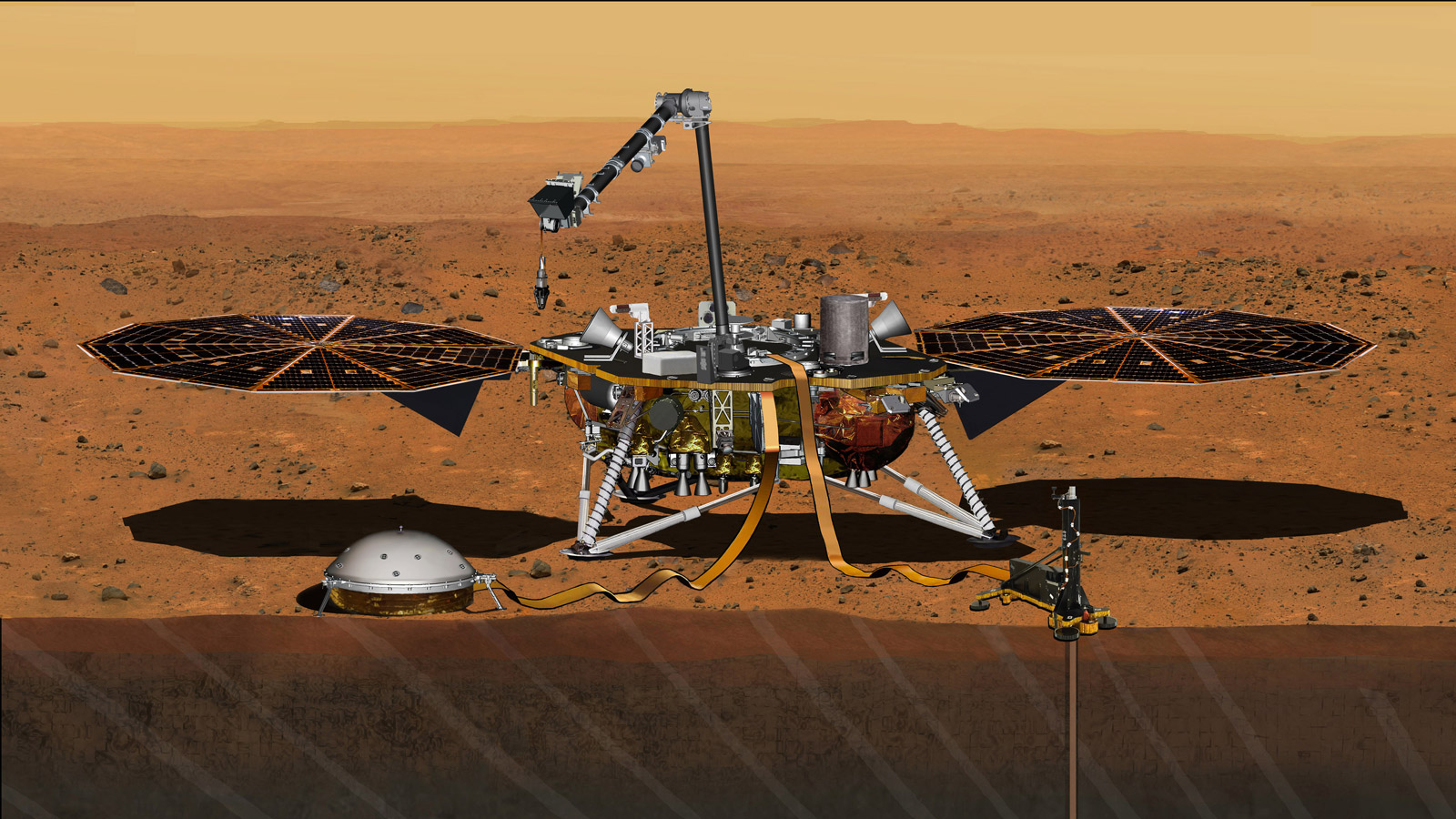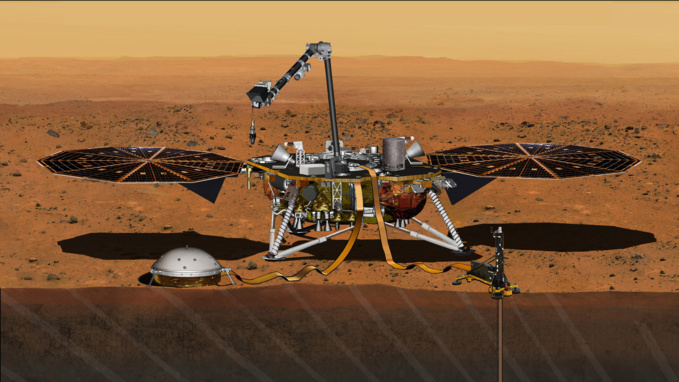Mars is one of the most studied celestial bodies, but this only stirs the interest of scientists. Apart from science fiction novels, the prospect of finding a microscopic life or its traces still stirs the minds of scientists.
Previously, natural depressions in the surface of the planet (for example, the Gale crater), where moisture could accumulate, were considered to be the most suitable for searching for life.
But, according to new findings of the researchers, dried hydrothermal springs are the most suitable for finding life on Mars — living organisms could live there, and maybe even still exist.
The fourth planet is also interesting to humanity from the point of view of colonization. Elon Musk is developing plans for how to reach Mars, and latest researches show that the so-called lava tubes under the surface of a celestial body will be good for settlements.
InSight was launched on May 5, 2018 from the Vandenberg Air Force Base in California. In total, the device spent almost seven months on the way, overcoming more than 140 million km. The lander completed its route in the Elysium volcanic region on the surface of Mars, having experienced “seven minutes of horror” while passing through the planet’s atmosphere.
The project cost $ 850 million, but promises a lot more than its predecessors, including the well-known twin rovers Spirit and Opportunity, and even their more advanced "brother" Curiosity. The latter is still working on the planet, the main purpose of the device is to search for life or its traces on the planet. Curiosity is able to independently take samples of the soil and carry out their analysis, but it will be incorrect to compare it with the vehicle arriving on Mars.
In fact, InSight is not a “rover”: the robot has no wheels and it will not travel around the planet. The device is rather a drill that can penetrate under the surface of the planet to a depth of six meters.
This will give scientists a whole layer of information: the device will conduct measurements of seismic activity on Mars, study composition of its subsoil, the temperature of the soil, and also conduct its chemical analysis.
Data from the device will allow experts to draw conclusions regarding the core and mantle of the Red Planet. NASA also notes that the research will determine how “similar” are composition of the Earth and Mars, and on the basis of this knowledge on the evolution of these celestial bodies of the Solar System will be refined.
Space research requires being pragmatic, so NASA experts could not help but use the InSight mission to conduct another experiment.
Two CubeSats (ultra-small satellites), named Wall-E and Eve, went to Mars together with InSight. NASA will try to use the devices, which were named after heroes of the cartoon, to transfer data from InSight to Earth at the moment when the device descends to the surface of the planet.
Live broadcast landing on Mars is technically difficult - too few vehicles in orbit around the planet to relay the signal. The Russian-European ExoMars-2020 consisted of two modules to provide real-time information and even then we didn’t immediately known about the unsuccessful landing.
However, NASA needs funding for this and future projects, and so the agency earns them by setting a show in exchange for investing in the next projects. Another attractive factor was the delivery of a microchip with InSight to Mars with 2.4 million enthusiast names noted on the site.
Such actions with sending names of fans into space are not uncommon. For example, this year alone, Japanese Hayabusa 2 spacecraft dropped a container with names of 180,000 people onto the Ryugu asteroid, and the Parker Solar Probe probe launched into the Sun also carries a chip on which more than 1.1 million people are recorded.
Mars has been, and remains, the closest guide of man in the two most important issues related to space: the search for life and the possible colonization of new worlds. Both the first and second is impossible without understanding of the fundamental processes of formation of celestial bodies, the characteristics of their structure and evolution.
InSight's mission is key to understanding structure and properties of Mars as a planet and a potential place to live. The future of such projects (in particular, their financing), but also, perhaps, a person’s view of their own planet, the Earth, depends on the success of the lander. And for this, the costs in the form of hundreds of millions of dollars, years of work and months of waiting seem not so great.
source: forbes.com
Previously, natural depressions in the surface of the planet (for example, the Gale crater), where moisture could accumulate, were considered to be the most suitable for searching for life.
But, according to new findings of the researchers, dried hydrothermal springs are the most suitable for finding life on Mars — living organisms could live there, and maybe even still exist.
The fourth planet is also interesting to humanity from the point of view of colonization. Elon Musk is developing plans for how to reach Mars, and latest researches show that the so-called lava tubes under the surface of a celestial body will be good for settlements.
InSight was launched on May 5, 2018 from the Vandenberg Air Force Base in California. In total, the device spent almost seven months on the way, overcoming more than 140 million km. The lander completed its route in the Elysium volcanic region on the surface of Mars, having experienced “seven minutes of horror” while passing through the planet’s atmosphere.
The project cost $ 850 million, but promises a lot more than its predecessors, including the well-known twin rovers Spirit and Opportunity, and even their more advanced "brother" Curiosity. The latter is still working on the planet, the main purpose of the device is to search for life or its traces on the planet. Curiosity is able to independently take samples of the soil and carry out their analysis, but it will be incorrect to compare it with the vehicle arriving on Mars.
In fact, InSight is not a “rover”: the robot has no wheels and it will not travel around the planet. The device is rather a drill that can penetrate under the surface of the planet to a depth of six meters.
This will give scientists a whole layer of information: the device will conduct measurements of seismic activity on Mars, study composition of its subsoil, the temperature of the soil, and also conduct its chemical analysis.
Data from the device will allow experts to draw conclusions regarding the core and mantle of the Red Planet. NASA also notes that the research will determine how “similar” are composition of the Earth and Mars, and on the basis of this knowledge on the evolution of these celestial bodies of the Solar System will be refined.
Space research requires being pragmatic, so NASA experts could not help but use the InSight mission to conduct another experiment.
Two CubeSats (ultra-small satellites), named Wall-E and Eve, went to Mars together with InSight. NASA will try to use the devices, which were named after heroes of the cartoon, to transfer data from InSight to Earth at the moment when the device descends to the surface of the planet.
Live broadcast landing on Mars is technically difficult - too few vehicles in orbit around the planet to relay the signal. The Russian-European ExoMars-2020 consisted of two modules to provide real-time information and even then we didn’t immediately known about the unsuccessful landing.
However, NASA needs funding for this and future projects, and so the agency earns them by setting a show in exchange for investing in the next projects. Another attractive factor was the delivery of a microchip with InSight to Mars with 2.4 million enthusiast names noted on the site.
Such actions with sending names of fans into space are not uncommon. For example, this year alone, Japanese Hayabusa 2 spacecraft dropped a container with names of 180,000 people onto the Ryugu asteroid, and the Parker Solar Probe probe launched into the Sun also carries a chip on which more than 1.1 million people are recorded.
Mars has been, and remains, the closest guide of man in the two most important issues related to space: the search for life and the possible colonization of new worlds. Both the first and second is impossible without understanding of the fundamental processes of formation of celestial bodies, the characteristics of their structure and evolution.
InSight's mission is key to understanding structure and properties of Mars as a planet and a potential place to live. The future of such projects (in particular, their financing), but also, perhaps, a person’s view of their own planet, the Earth, depends on the success of the lander. And for this, the costs in the form of hundreds of millions of dollars, years of work and months of waiting seem not so great.
source: forbes.com



















